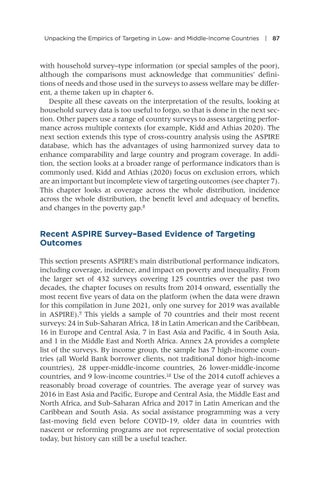Unpacking the Empirics of Targeting in Low- and Middle-Income Countries | 87
with household survey–type information (or special samples of the poor), although the comparisons must acknowledge that communities’ definitions of needs and those used in the surveys to assess welfare may be different, a theme taken up in chapter 6. Despite all these caveats on the interpretation of the results, looking at household survey data is too useful to forgo, so that is done in the next section. Other papers use a range of country surveys to assess targeting performance across multiple contexts (for example, Kidd and Athias 2020). The next section extends this type of cross-country analysis using the ASPIRE database, which has the advantages of using harmonized survey data to enhance comparability and large country and program coverage. In addition, the section looks at a broader range of performance indicators than is commonly used. Kidd and Athias (2020) focus on exclusion errors, which are an important but incomplete view of targeting outcomes (see chapter 7). This chapter looks at coverage across the whole distribution, incidence across the whole distribution, the benefit level and adequacy of benefits, and changes in the poverty gap.8
Recent ASPIRE Survey–Based Evidence of Targeting Outcomes This section presents ASPIRE’s main distributional performance indicators, including coverage, incidence, and impact on poverty and inequality. From the larger set of 432 surveys covering 125 countries over the past two decades, the chapter focuses on results from 2014 onward, essentially the most recent five years of data on the platform (when the data were drawn for this compilation in June 2021, only one survey for 2019 was available in ASPIRE).9 This yields a sample of 70 countries and their most recent surveys: 24 in Sub-Saharan Africa, 18 in Latin American and the Caribbean, 16 in Europe and Central Asia, 7 in East Asia and Pacific, 4 in South Asia, and 1 in the Middle East and North Africa. Annex 2A provides a complete list of the surveys. By income group, the sample has 7 high-income countries (all World Bank borrower clients, not traditional donor high-income countries), 28 upper-middle-income countries, 26 lower-middle-income countries, and 9 low-income countries.10 Use of the 2014 cutoff achieves a reasonably broad coverage of countries. The average year of survey was 2016 in East Asia and Pacific, Europe and Central Asia, the Middle East and North Africa, and Sub-Saharan Africa and 2017 in Latin American and the Caribbean and South Asia. As social assistance programming was a very fast-moving field even before COVID-19, older data in countries with nascent or reforming programs are not representative of social protection today, but history can still be a useful teacher.


